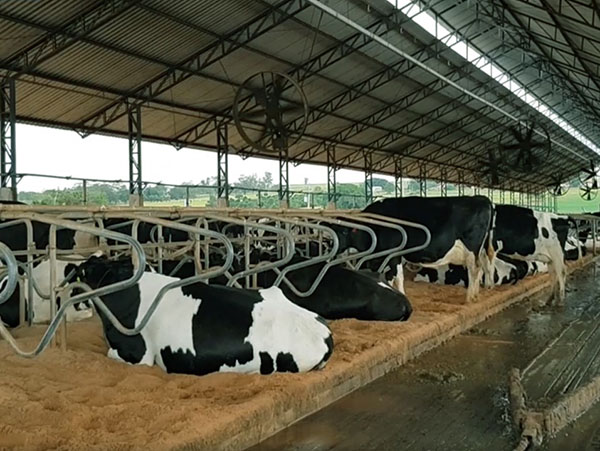It must provide enough space for the largest cow in the herd to freely enter the barn, lie down, rest comfortably and easily stand up and leave the barn. To do this, free stallers must take into account the cow's normal desire to rest face up, change resting positions or stretch while recumbent, and move forward to lift her hindquarters first when standing up.
To minimize hoof problems and encourage cows to rest, bedding should be clean, dry and comfortable.
Check out 8 free stall management tips below that help ensure all the benefits that this confinement system can provide:
1) Correctly size the mattress
Various materials can be used for cow bedding, such as straw, wood shavings (saw dust), low-quality hay, earth, sand and rubber mattresses. When using mattresses, these should be 2.5 to 7.6 centimeters high at all times to ensure the cows remain clean and comfortable. Every time the cows go to milk, the manure and urine must be cleaned.
2) Replace old mattresses when necessary.
The maximum lifespan of most foam or rubber mattresses is 10 years. During this time, the foam or rubber is compressed, making the surface very hard.
The use of free stalls as a way of housing cows involves significant investments. Therefore, maximum individual production per cow must be sought as a way to make the system viable.
Maintaining beds so that they do not hurt the cows and encourage them to lie down is a fundamental aspect to guarantee comfort in the installation. Without this, production will certainly not be optimized, although costs (food, medicine, personnel, depreciation, etc.) exist in the same way.
3) Design appropriately sized stalls for the cows.
Make stalls that fit the largest cow in the herd. Stalls that are too small discourage cows from using them because they may have difficulty lying down or getting up, and sometimes even injure themselves in the process.
The correlation between stall size and incidence of problems is important. The current recommendation is to work with a total length of 2.40 m to 2.50 m, with 1.70 to 1.80 m for laying the animal's body (cows weighing 550 to 650 kg) and the remainder for the frontal movement of the head. .
4) Keep the stalls full of sand when opting for this material.
When cows go up and down from their stalls, they tend to throw sand away. This often leaves a depression, particularly at the back of stalls, where moisture and urine can accumulate creating unsanitary bedding conditions.
The low level of sand in the beds makes them less comfortable, not providing the desired “cushioning” effect when the cows lie down or get up. When the level is low, it is common for the front part of the bed (where the animal rests its front limbs) to be even lower, which makes it difficult for the cow to move when getting up (discomfort). Furthermore, the dimensions of the bed are changed, becoming disproportionate to what was designed.
5) Always keep the stalls prepared for the return of the cows.
Manure and urine-wet sand must be removed when the cows leave for each milking, so that they are always ready to receive the animals in the best possible comfort and hygiene conditions.
6) Slope the sand toward the back of the stall.
When arranging the stalls, the sand should be sloped towards the rear, with a slope of 2% to 3%, as this facilitates the movement of the cow.
7) Use the right sand.
Very fine sand does not separate from the manure solids and therefore cannot be reused. If it is too thick or has stones, it can increase the risk of hoof injuries.
The use of poor quality sand, even though it is cheaper, will certainly bring more harm than good. The presence of a large number of impurities, such as stones, for example, bothers cows and they avoid bedding. Sand particle size, no matter how detailed, can be quite important. Sand with particle sizes less than 0.3 mm in diameter tends to suffer much greater compaction with the weight of the animals, reducing comfort in addition to making cleaning the beds difficult.
Ideally, it should always be washed and sieved before being purchased. If it arrives at the property still wet, it must be placed in an airy place so it can dry. It is not recommended to use wet sand in free-stall beds.
To find out if a given sand has adequate particle size and moisture to be used as a bed in a free-stall, we can perform a very simple and practical test such as: forming a “ball” of sand with our hands and throwing it from one hand. to another. If it does not break (thresh), we possibly have very wet sand, or with very small particle size or even these two characteristics.
8) When reusing, replace with the cleanest sand possible.
If you are reusing sand, make sure the drying time is sufficient. Reused sand should have 10% to 12% of moisture with less than 2% of organic matter, as higher levels can lead to more mastitis over time.
Studies suggest that reused sand can be used as bedding material and is safe and comfortable for dairy cows. However, care must be taken with how many times it is used. Currently, it has not been determined what the limit of bacterial load in reused sand is and how many times the material can be recovered, without risk to cows' health.




